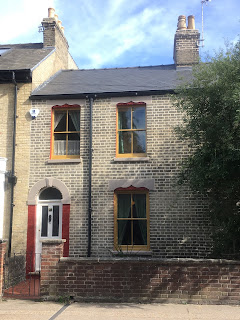Back in about March, I hard about the David Parr House, in Cambridge, and in September, I visited. I had to wait so long because access is very limited, due to the house's size, so it is necessary to pre-book - it looks as though you can currently book slots in July and August 2020.
David Parr was an artisan who was born in 1854,and in 1871 he became an apprentice with a firm, F.R.Leach, which carried out decorative work, for various churches, colleges and homes in Cambridge and beyond, including carrying out work as subcontractors for William Morris and others.
In 1886, David Parr bought a small, terraced house, at 186 Gwydir Street, near Cambridge Station, and moved in there with his wife and eldest child.
Over the next 40 years, Parr decorated the house using the same skills and styles he employed in his work. The walls are hand painted, using 'pouncing' (marking out the pattern using charcoal, through pricked holes in tracing paper) but no stencils or wall paper!
In two of the rooms, there are also beautifully hand-lettered quotes - from Shakespeare and from hymns (Parr was a devout Christian)
As well as the walls (and ceiling) Parr also worked on the doors - the doorknobs and finger-plates were probably either samples or left over from properties he worked on, as they are all different (often on the same door), and used paint techniques to make the woodwork look like better quality woodwork .
He was also pretty forward thinking, and installed a magnificent indoor toilet!
David Parr and his wife raised their children in the house, then, following Parr's death in 1927, his widow remained living there, with their granddaughter Elsie, who was 12 at the time.
Elsie remained living in the house for the rest of her life. She married and she and her husband brought their children up in the house, preserving her grandfather's decor. There were some changes - the house suffers from damp, and Elsie and her husband had to paint over part of the drawing room wall (It has now been restored),after it became damaged by damp, and the upper part of the hall walls were painted white as the original decor made it very dark.
The house is also furnished with Elsie's furniture . She died in 2013, at the age of 98. It was then that the house was bought, and a trust set up to restore it. It's beautiful, fascinating, and I think perhaps unique, both for an artisan to have decorated his own home in this kind of style and for it to have survived.
(They don't allow you to take photographs inside, sadly, but the Guardian has a gallery here, it's well worth taking a look)
If you are interested in going, You can book on the house's website.

No comments:
Post a Comment